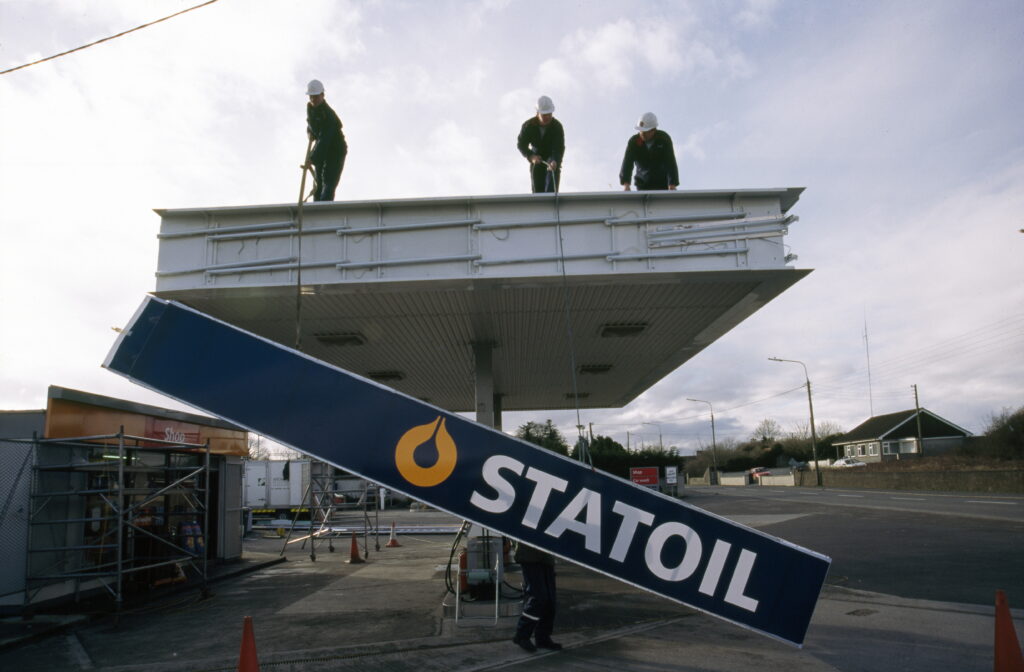From service stations to exploration and production

An oil company can potentially become engaged along the whole value chain from exploration, via production, transport, storage, processing and distribution to sales – through service stations, for example.
Exploration and production are often defined as upstream activities, with transport and storage designated as midstream. The subsequent stages – processing, distribution and sales – are then termed downstream. An oil company engaged in every one of these stages can be considered fully integrated.[REMOVE]Fotnote: It can also be described as fully vertically integrated.
Johnsen’s integration
As Statoil’s first CEO, Arve Johnsen’s aim was to achieve such integration. Being involved along the whole value chain seemed to offer benefits which were in the interests of both company and state.
An important aspect of Norwegian petroleum policy was that offshore exploration and production should benefit industrial jobs on land. One example was the use of oil and gas from Norway’s continental shelf (NCS) as petrochemical feedstock, where an important initiative was the creation of a large industrial complex in the Bamble area south-west of Oslo. This would produce a wide range of products based in part on by-products from petroleum refining.
One challenge was that profitability could vary between the various parts of the value chain. The refining stage, for example, had excess capacity for long periods and thereby poor earnings.
A general issue in Norway was how ownership should be organised in areas such as refining, petrochemicals and service station operation. This was resolved on a number of occasions by the Norwegian oil companies – Statoil, Norsk Hydro and Saga Petroleum – agreeing on a collaboration.
Upstream in centre stage
A growing emphasis on international exploration and production emerged under CEO Harald Norvik in the second half of the 1990s.[REMOVE]Fotnote: Boon, Marten, 2022, En nasjonal kjempe. Statoil og Equinor etter 2001. Universitetsforlaget: 119; on the sale of Statoil shipping company Navion, see annual report, 2002, Statoil: 33. (References to annual reports in this text refer to the Norwegian edition of the reports.) While Helge Lund was CEO from 2004, this upstream activity was cultivated seriously. It was thereby also clear that selling out completely from other parts of the value chain, such as petrochemicals and service stations, could become relevant. But opposition to doing this might be substantial. One example is developments in petrochemicals.
When Lund proposed selling the remaining stake in petrochemicals company Borealis, employee representatives on the Statoil board reacted. They pointed to the obligations to help ensure growth in Norway’s mainland industries.[REMOVE]Fotnote: Boon, Marten op.cit: 122-123. However, the CEO’s proposal was approved with the votes of the other directors.
This board decision has been interpreted as a clear indication of how the company, after its partial privatisation in 2001, put capital market interests ahead of more or less clearly defined expectations from politicians and others about which national commitments it should fulfil.[REMOVE]Fotnote: Ibid: 123.

The reduction in the downstream business continued. Activities related to motor fuels and retailing were transferred in 2010 to a separate company called Statoil Fuel & Retail and listed on the stock market. At the time, this enterprise had 2 283 service stations spread across Norway, Sweden, Denmark, Poland, Estonia, Latvia, Lithuania and Russia.[REMOVE]Fotnote:Annual report, 2010, Statoil: 6. In 2012, Statoil Fuel & Retail was sold to Canada’s Alimentation Couche-Tard.[REMOVE]Fotnote: Annual report, 2012, Statoil: 37.
Statoil’s strategy under Lund gave particular emphasis to growth related to international exploration and production – particularly in North America. An example is the acquisition of Canada’s EnCana.[REMOVE]Fotnote: Boon, Marten, op.cit: 152. This type of choice corresponded to a great extent with general development trends in the oil industry.
Symbolic neighbours
Decisions on prioritisation between upstream, midstream and downstream operations were largely taken at Statoil’s head office in Stavanger. Among its nearest neighbours is one of Norway’s most symbolic service stations. In the early 1990s, it was the first to carry the Statoil livery.
On an April day in 2017, this was also where the last of this signage was removed. That marked the end of a long real, but not least visual, association between frankfurters, pumps and Norway’s biggest petroleum company.
By that time, many years had passed since the service station’s big neighbour had seriously turned its attention towards exploration and production – and eventually also towards a broader energy perspective.
arrow_backFrom fracking to renewables in ArgentinaPotential major accident on Songa Endurancearrow_forward